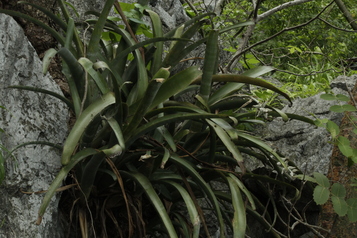bacuela gui'xhi' This name is given to at least two different species of the [...]
| Part of Speech | s |
| PDLMA | ba-kwe*lla* gi7xi |
| Speaker | {FSL12,FSL14,RLC14,VOT14} |
-
- This name is given to at least two different species of the Bromeliaceae family, including <Bromelia palmeri> and <Tillandsia ionantha>. <B. palmeri> is a plant endemic to Mexico. The species known as <bacuela gui'xhi'> can have a number of different forms, such as herbs, plants that grow among rocks (rupicolous), plants whose leaves are arranged like rose petals (rosetophilous) and plants that grow on other plants (epiphytes). The epiphyte <bacuela gui'xhi'> plants grow on trees and cactuses. However, they are not parasitic as they do not extract any resources from the plant they develop on. The species found in La Ventosa are usually small and do not exceed 0.5 meters in height. They are abundant in La Ventosa. The plant known as <bacuela gui'xhi'>, which corresponds to <Tillandsia sp.>, produces an inflorescence with purple flowers. These flowers, which have no aroma, are used at Christmas for the manger of the Baby Jesus. Another plant produces a spherical fruit with a bittersweet flavor and is still considered edible by some people. Yet another plant has leaves shaped like a hammock under which armadillos shelter.
- La piñuela. Nombre que se le da por lo menos a dos especies distintas de la familia Bromeliaceae incluyendo <Bromelia palmeri> y <Tillandsia ionantha>. Entre estas, <B. palmeri> es una planta endémica de México. Las especies designadas por el nombre <bacuela gui'xhi'> pueden tener diversas formas de vida incluyendo hierbas, plantas que crecen entre rocas (rupícolas), plantas cuyas hojas se disponen como una rosa (rosetófilas) y plantas que viven sobre otras plantas (epífitas). Las <bacuela gui'xhi'> son epífitas que viven sobre árboles y cactus. Como tales, no son plantas parásitas y no extraen ningún recurso de la planta sobre la cuál se desarrollan. Las especies que se encuentran en La Ventosa, donde se les considera abundantes, suelen ser pequeñas y no medir más de medio metro de altura. Una de las plantas designadas como <bacuela gui'xhi'>, < Tillandsia sp.>, produce una inflorescencia de flores moradas sin aroma y se utiliza en Año Nuevo para hacer el pesebre del Niño Jesús. Otra más produce frutos esféricos de sabor entre dulce y amargo que algunas personas aún consideran comestibles. Otra más tiene pencas (hojas) de forma similar a la de una hamaca bajo las cuáles se refugian los armadillos. [Spanish]
- Nuu xtaleni rabicabe bacuela gui'xhi'. Nuuni la? rindanini lade guie casi ñacani guixi; ne nuuni la? ca xpandagani rului'cani ti guie'bixigui'; ne laaca nuuni la? rului'cani luba´, rirendacani lu yaga ne lu bidxí, xisi la? qué re'dicani tini, rigapisini ca yagadi'. Ca bacuela gui'xhi' nuu lu Guidxi Rialle Bi la? nabiuxecani, qué risoope'cani, nuuru' xtaleni. Ti bacuela gui'xhi'di' rudiini ti guie' naguhui, qué gapani xho'. Binni riquiiñeni lu beeu iza yooxho' racani xquela niñu. Dxique ca binni ra ñaa biyaanacani xhiuzeca' casi ñacani bacuela. Ne xti bacuela gui'xhi'ca la? rudiini ti xcá nalolo ni nanaxhi nandá', nuu binni ná rócabeni. Ne nuu xti bacuela gui'xhi' la? ribee caadxi batuuba ni rireeche layu casi ñacani guixhe, naxhiini, xa'na'ni nga riuu ngupi runi lidxi. [Diidxazá]
-
-
Example 4:
bacuella gui'xhi ca la? ridxélani ndani ca gui'xhi ra ra jmá naxhii ca la? ne lu dàni ne lu uriá dàni ca la? ne ribeeni ne stale stale claseni, rápani guiichi puntani la? ne ribeeni ti guie' huini xiña' casi xcola, casi xcola mani xubi ne dxiqué la? ruyanacabeni, ró bueyni ca ni ricá lu yaga cathe bacuella gui'xhi grows in the thick forests and also on the hills and at the edge of the hills, and it produces... there are many kinds, it has a thorn on the tip, it produces a small red flower which looks like the tail of a scorpion, and in the past it was fed to the bulls when they were tied upla piñuela se encuentra en los montes más boscosos y en cerros y en orillas de cerros y da, y hay de muchos tipos, tiene una espina en la punta y saca una florecita roja como la cola de, como la cola de alacrán y anteriormente se lo daban de comer a, lo comían los bueyen que estaban atados [Spanish]
-
Taxa <Billbergia pallidiflora>;<Bromelia palmeri>;<Hechtia isthmusiana>;<Hechtia rosea>;<Hechtia>;<Tillandsia caput-medusae>;<Tillandsia concolor>;<Tillandsia hammeri>;<Tillandsia ionantha>;<Tillandsia makoyana>




















































